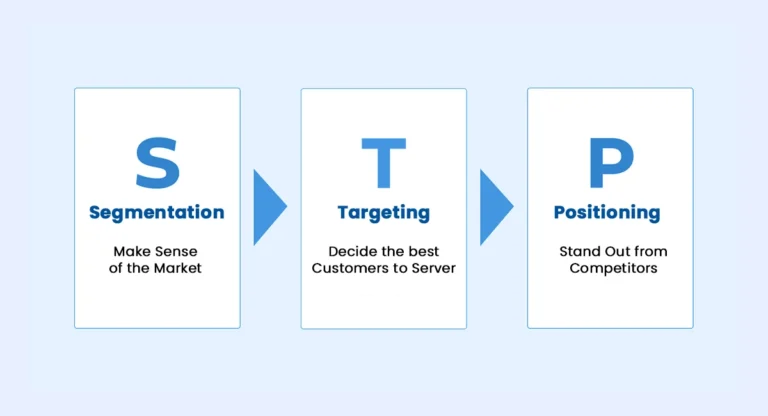The STP model, short for Segmentation, Targeting, and Positioning, is a marketing strategy that categorizes a larger market into smaller groups. It then identifies the most important market to target while positioning a product or service so that it meets the needs of that specific group. This helps businesses reach the appropriate consumers and attain greater profitability.
Table of Contents

Market segmentation is the division of the market into smaller, unique groups of consumers who have similar characteristics, preferences, or needs. This way, marketers can target specific clusters in a large audience with a tailored message.
Demographic segmentation: Divides the consumers according to age, gender, income, education, or occupation.
Geographic segmentation: Focuses on location-based preferences, such as country, city, or climate.
Psychographic segmentation: Groups consumers by lifestyle, personality, values, and interests.
Behavioural Segmentation: Analyzes purchasing behavior, brand loyalty, and product usage.
Effective segmentation allows businesses to better understand their audience, personalize their marketing strategies, and avoid a one-size-fits-all approach. For example, a company like Nike segments its market based on lifestyle and performance needs, ensuring tailored campaigns for athletes and casual consumers alike.
After the market segmentation, the target is made. This process is done by selecting only a few suitable segments to focus on, depending on their promising profitability and adherence to the company’s goals.
Market Size: Is the segment large enough to be profitable?
Growth Potential: Does the segment have room for expansion?
Compatibility: Does the segment align with your brand’s values and capabilities?
Competitive Landscape: How saturated is the segment, and can you offer something unique?
Undifferentiated Marketing: Focuses on the entire market with one universal message.
Differentiated Marketing: Targets multiple segments with unique strategies for each.
Concentrated Marketing: Focuses on one specific segment (e.g., luxury brands targeting high-income groups).
Micromarketing: Personalizes marketing for very small groups or individuals.
Positioning is building a unique, desirable perception of your product or service in the minds of your target audience. This step defines how your brand will differ from competitors and serve the needs of your chosen segments.
Competitive Advantage Identification: Identify the difference your product makes in quality, price, or innovation.
Develop a Positioning Statement: A short statement that communicates your product’s unique value to the target segment.
Design the Marketing Mix: Align your product, price, promotion, and distribution strategies with your positioning.
Apple: Positions itself as a premium brand offering innovative, user-friendly products for tech enthusiasts.
Coca-Cola: Focuses on happiness and togetherness, resonating emotionally with consumers across the globe.
Improved Customer Focus: By strategizing, the businesses aim to cater to specific customer needs effectively
Higher ROI: Targeted communications yield higher levels of conversion than marketing waste
Deeper Brand Loyalty: Personified messages work better with forming emotional relationships among customers
Competitive Advantage: The focused brand can hold its position, even in competitive markets.
Understanding the funnel meaning in digital marketing can further enhance targeting and lead to improved conversion rates.
Coca-Cola segments its market geographically, demographically, and psychographically. It owns brands such as Diet Coke for the health-conscious and Coke Zero for the younger, calorie-conscious population.
Airbnb’s target market comprises solo travellers, families, and luxury enthusiasts. The company caters to these segments by creating unique experiences and accommodations for its users.
Tesla markets itself as an innovative and sustainable company, targeting high-income, environmentally conscious consumers. The company’s message is advanced technology and responsibility to the environment.


Step 1: Research Your Market
Understand your audience through surveys, focus groups, and data analysis.
Step 2: Identify Segments
Group your audience based on shared characteristics.
Step 3: Select Your Target Market
Evaluate the potential of each segment and select the one(s) that best align with your goals.
Step 4: Positioning Strategy
Determine how your product will be perceived and create messaging that will highlight its unique value.
Step 5: Execute and Monitor
Launch targeted campaigns and continuously monitor their performance for optimization.
Data Overload: Analyzing large datasets can be overwhelming without the right tools.
Market Dynamics: Consumer preferences evolve, requiring regular updates to segmentation strategies.
Resource Allocation: Focusing on specific segments may limit broader opportunities.Understanding digital marketing advantages and disadvantages is key to overcoming resource allocation and market dynamics challenges.This way, with digital marketing, the STP method has become much more effective. Facebook and Google have developed even more advanced ways of segmenting audiences and allowing targeting of specific advertisements. AI and machine learning further narrow down the opportunity for creating hyper-personalized campaigns that will gain higher engagement.
Dynamic websites allow for frequent updates, keeping content fresh and relevant for search engines. However, without proper optimization, their slower speeds can negatively impact performance.
The STP framework of modern marketing strategy is based on segmentation, targeting, and positioning. Understanding the principles of segmentation, targeting, and positioning enables a business to deeply connect with its audience, provide individualized experiences, and ultimately obtain a competitive edge.
As markets become more competitive, partnering with a reliable digital marketing agency can help businesses implement an effective STP strategy and reach their ideal audience.Whether you are a startup or an established enterprise, this framework will unlock new levels of success for your marketing campaigns.
“Marketing’s job is never done. It’s about perpetual motion. We must continue to innovate every day.” – Beth Comstock. Let STP guide your way in this ongoing journey!
Nirbhay Chauhan is a Performance Marketing and ROI Specialist with expertise in SEO, PPC, and media planning. With a passion for data-driven strategies, Nirbhay helps businesses scale by optimizing their marketing efforts to deliver measurable results. His extensive experience in driving online growth and maximizing ROI makes him a trusted partner for businesses looking to elevate their digital presence.